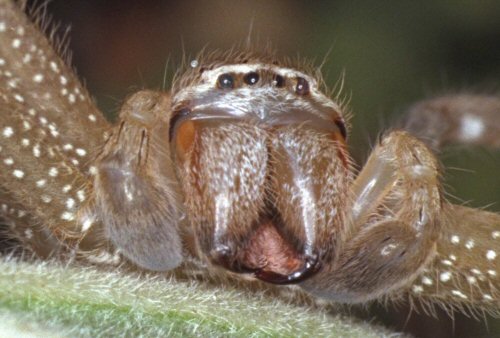

Primitive spiders, Mygalomorphae, have forwardly pointing jaws that move forwards and backward in contrast to the modern spider who move their jaws sideways.
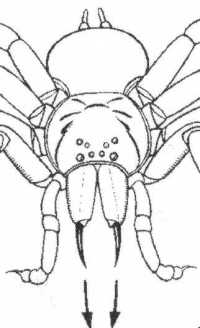
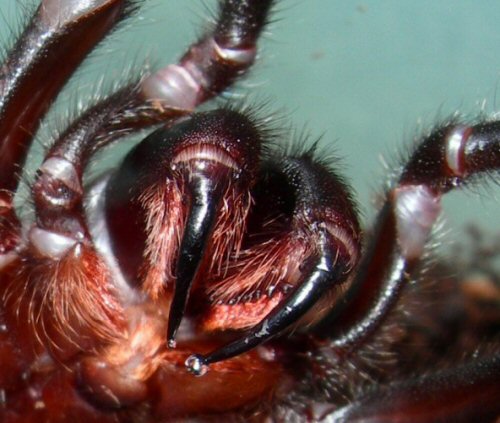
|
The jaws and poison |
|
|
. |
The jaws and poison
Spiders use their legs and jaws to catch prey. The jaws end in the fangs that
are punched throught the skin of a prey when the victim is under control.
Venom is injected throught the hollow fangs that are connected to venom glands
in the head of the spider. After a short time the animal stops strugling and
dies.
 |
 |
| Modern spider, Neosparassus salacius | |
Primitive spiders, Mygalomorphae, have forwardly pointing jaws that move forwards and backward in contrast to the modern spider who move their jaws sideways. |
|
 |
 |
| Primitive spider, Atrax robustus | |
 |
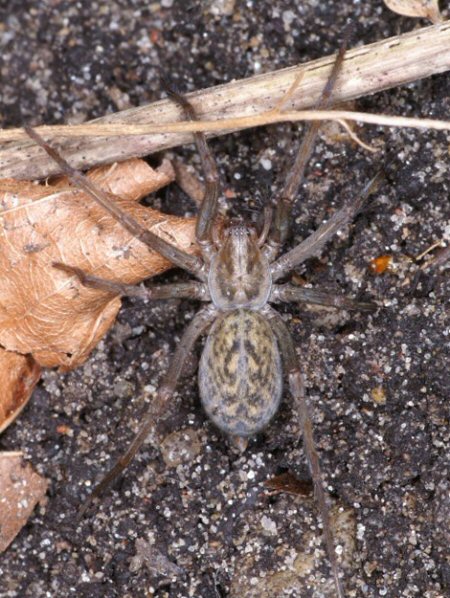 |
| Primitive spider, Brachypelma smithi | Modern spider, Tegenaria atrica |
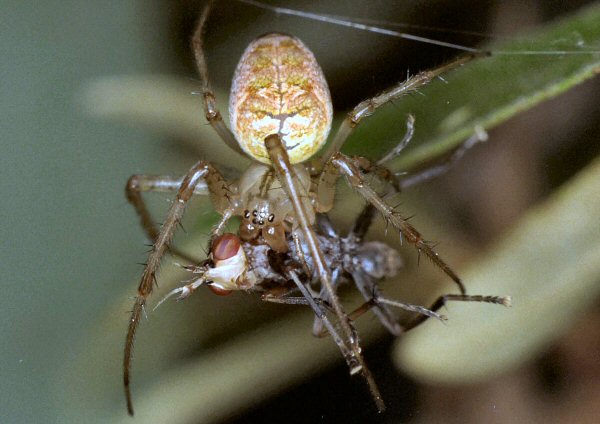 |
|
Meta segmentata with her jaws into a fly |
|
The venom of a spider contains protein, amines and polypeptides.
Some of these molecules are capable of disrupting the communication between the
nervous system and the muscles, which causes paralysis.
Other molecules cause death of cells, which leads to necrosis.
After the prey is caught the spider inject this mixture from glands in the head
throught the its fang into the victim. The fang resembles a hypodermic needle.
It is hollow and ends in a sharp point.
When the victim is dead the spider injects digestive fluid into the victim.
Enzymes in the venom mixture dissolves the prey.
Mammals dissolve their meal in a stomach using the enzyme pepsin. So in
contrast to many animals the spider digests proteins of the prey in the prey
itself. It uses the prey as an external stomach.
How lethal is the poison of a spider? This is difficult question to answer.
A poison toxity is expressed as LD50 to express its toxicity. LD50 stands for
the amount of venom, the Lethal Dose, needed to kill 50% of a tested population
of animals.
The poison of a black widow spider has a LD50 of 0.9 mg per kg mouse.That is
0.013 mg per mouse. The spider needs 2 mg to kill half of the frogs. So the
lethality differs among animals.
Horses, cows and sheep are more sensitive to black widow spiders than humans.
Rabbits, dogs and goats are hardly affected by the black widow bite.
A LD50 test has never been performed on humans. Therefore it is difficult to
calculate how poisonous a spider is to humans and express it in a LD50.
|
|
|
|
Jaws (chelicererae) and fangs of the house spider Tegenaria atrica |
|
The lethality of spider's poison to humans is much exaggerated. However there
are spiders that can hurt humans.
The Latrodectus
species (Black widow), the Australian Sydney funnel web spider,
Atrax robustus, are best to be avoided.
These spiders use a venom that disturbs the nerve system, which can cause heart
rhythm disturbances, cramps, shaking, pain and dizziness.
The bite of tarentulas (mygalomorphs),
the bird eating spiders, is harmless for us and comparable to a bee sting in
effect althought the big fangs can hurt if you get bitten.
|
|
|
|
The black widow, Latrodectus hasselti |
Crab spider with prey |
There are also some spiders that give a nasty bite comparable to the stinging
of a wasp or less.
Most of the venom injected with these bites causes cell death and gives rise to
a wound that does not heal properly and becomes easily infected.
In Europe there is the water spider,
Argyroneta aquatica, which has a very nasty bite. Immediate cooling of
the wound is the best medicine.
An overview of dangerous spiders in the world can be found here:
The demystification of the toxicity of spiders.
Most modern spiders crunch their catch with their jaws. Other spiders wrap
their prey in silk, taking care that the victim does not bite them.
Orb weaving spiders make a parcel of
the prey and wait until the prey is dissolved before sucking it empty.
Crab spiders do not use silk but use
a rapid working poison.
Spiders of the family Uloboridae
do not have any poison and put their trust completely on their silken thread.
|
|
|
Orb weaving spiders like this Argiope syrmatica wraps her prey before sucking it empty. |
 |
The injected enzymes dissolve the prey and then its
dissolved contents is sucked up by the spider. The mouth of a spider is located between the palps which are connected to the stomach muscles that perform the sucking. Between mouth and stomach is a filtering device that is made up of thousands of fine hairs. Only particles smaller than 1 mm can pass through this filter. This filter is so precise that even the particles in India ink will be filtered out so that only water can pass through. With these filters the spider prevents bacteria, viruses and other harmful life forms from entering its own body. The filter is regularly cleaned with the spider's upper and lower lips. |
| Young spider caught by jumping spider Helpis minitabunda |
Because the food that is taken up can be large in comparison to its own body
volume, the abdomen of the spider can swell enormously.
The digested proteins are stored in a special place. This makes it possible for
the spider to live for several weeks on a single prey.
The waste substances are chemically converted to harmless crystals and are
stored in special cells.
These white colored guanocytes are located in-groups and can be seen through the
skin. This shows up as a very special pattern on the back of the orb weaving
spiders.
Special excretory organs separate these waste substances from the blood. The
spider kidneys consist of two long thin tubes, called Malpighian tubules.
Ed Nieuwenhuys, 23 march 2023
December 2011, January 2008, November 2006
Next: Blood circulation, the lungs and moulting